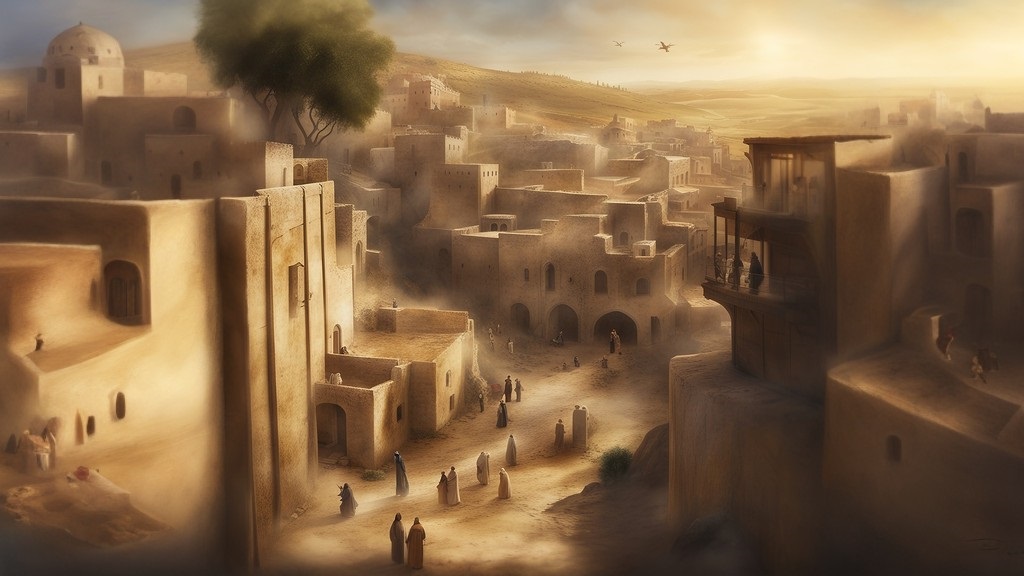
Living Conditions in Israel During the Time of Jesus Christ
Introduction
Living in ancient Israel during the time of Jesus Christ, from 4BC to AD30, was vastly different from our contemporary experience. The living conditions, housing arrangements, types of jobs, class divisions, food, hygiene, art, and leisure all reflected a culture steeped in tradition and the socio-political landscape of the time.
Living and Housing Conditions
Most people in ancient Israel lived in agrarian communities, often in homes that were a blend of residence, workspace, and livestock pen. Homes were simple and functional, typically constructed from locally sourced materials such as stone and mud-brick. The buildings usually contained a main room for cooking, eating, and sleeping, with additional rooms for storage and workspace.
A home's construction reflected the harsh climate, with small windows to keep out the hot summer sun and a flat roof that could be used for storage and sleeping during the warmer months. The roof was also used for collecting rainwater, a vital resource in the arid landscape of Israel.
Supporting Scripture:
Luke 5:19 discusses a man being lowered through a roof to be healed by Jesus, which implies the flat and accessible nature of roofs in Israel at the time.
And when they could not find by what way they might bring him in because of the multitude, they went upon the housetop, and let him down through the tiling with his couch into the midst before Jesus.
Jobs and Class Divisions
The majority of Israel's population were subsistence farmers, tending to small plots of land where they grew wheat, barley, olives, grapes, and other crops. Others raised livestock like sheep, goats, and cattle. A smaller number were engaged in skilled crafts such as pottery, carpentry, and weaving. Fishing was also a common occupation, particularly in communities near the Sea of Galilee.
The society was divided into distinct classes. At the top were the priests and educated scribes, followed by wealthier landowners, merchants, and artisans. At the bottom were the laborers, farmers, servants, and slaves.
Supporting Scripture:
Matthew 4:18-19 speaks of Jesus encountering the fishermen Simon Peter and Andrew, indicating the prevalence of fishing as an occupation.
And Jesus, walking by the Sea of Galilee, saw two brethren, Simon called Peter, and Andrew his brother, casting a net into the sea: for they were fishers. And he saith unto them, Follow me, and I will make you fishers of men.
Food and Its Acquisition
Food in ancient Israel was largely based on what the land and sea could provide. The typical diet consisted of bread, lentils, olives, fish, and occasionally meat from livestock. Milk from goats and sheep was used to make cheese. Vegetables and fruits like cucumbers, melons, figs, and pomegranates were also common.
Bread, the staple of the diet, was often baked at home in clay ovens. Fish was dried or pickled, and meat was typically eaten only on special occasions due to its cost. Food acquisition was primarily through farming, fishing, and animal husbandry, though trading for goods at local markets was also common.
Supporting Scripture:
In John 6:9, a boy offers Jesus five barley loaves and two fish, demonstrating the typical diet of the time.
There is a lad here, which hath five barley loaves, and two small fishes: but what are they among so many?
Hygiene
Hygiene in ancient Israel was deeply tied to religious laws and customs. Ritual washing was a common practice and served both religious and practical cleanliness purposes. Public bathhouses, while not as common as in Roman culture, did exist in some urban areas.
Supporting Scripture:
Mark 7:2-4 refers to the tradition of ritual washing before eating.
And when they saw some of his disciples eat bread with defiled, that is to say, with unwashen, hands, they found fault. For the Pharisees, and all the Jews, except they wash their hands oft, eat not, holding the tradition of the elders. And when they come from the market, except they wash, they eat not. And many other things there be, which they have received to hold, as the washing of cups, and pots, brasen vessels, and of tables.
Art and Leisure
Art in ancient Israel was heavily influenced by religious beliefs. Pottery, mosaics, and frescoes often depicted biblical narratives or symbolized religious concepts. However, the creation of human and animal images was limited due to the second commandment's prohibition against graven images.
In terms of leisure, the Sabbath was an important day of rest and worship. Music and dance were integral parts of religious festivals and celebrations. Games, particularly those involving balls and sticks, were common pastimes for children, while adults engaged in storytelling and debate.
Supporting Scripture:
Exodus 20:4 is the Second Commandment, which prohibits the creation of graven images.
Thou shalt not make unto thee any graven image, or any likeness of any thing that is in heaven above, or that is in the earth beneath, or that is in the water under the earth.
The living conditions in ancient Israel during the time of Jesus Christ were austere by today's standards, shaped by the realities of the land and the sociopolitical climate. Though life was often challenging, the culture was rich with tradition, symbolized by unique artistic expression and profound religious customs. The food, work, and housing all represented a society deeply intertwined with its natural surroundings, and each class, from the high priests to the lowly shepherds, played a vital role in the communal fabric of life.